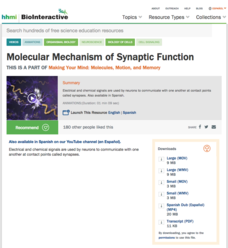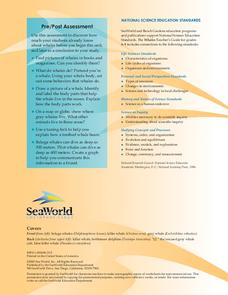Curated OER
Animal Issues: Let's Talk Turkey
Thanksgiving means an untimely demise for thousands of turkeys every year. This turkey Q and A provides nine questions bringing facts and statistics of turkey consumption to the discussion table. There is an answer key that provides full...
TED-Ed
What's the Big Deal with Gluten?
Is gluten-free just a fad? What is gluten anyway, and why can't some of us process it? This is the perfect video to break down the anatomy of gluten and the various diseases and symptoms caused by the notorious protein, as well as to...
Deep Look
These Fighting Fruit Flies Are Superheroes of Brain Science
What can fighting fruit flies tell us about our own brains? Junior geneticists explore the common genes of fruit flies and humans and learn how scientists are using the tiny insects to help study depression, anger, and Alzheimer's...
TED-Ed
What Are Those Floaty Things in Your Eye?
Ever find yourself looking at a clear blue sky and notice something that seems to be floating across your eye? Well, you're not alone. Watch this short video to find out exactly what causes this and other common visual phenomenon.
Deep Look
Archerfish Says..."I Spit in Your Face!"
In many cultures, spitting is considered rude; in the world of the archerfish, spitting just means you're trying to catch dinner! Journey to the mangroves of Southeast Asia to meet the archerfish, an expert marksman that shoots insects...
Deep Look
This Is Why Water Striders Make Terrible Lifeguards
Water striders ... amazing aquatic acrobats or ferocious predators? Introduce life science scholars to these tough little insects using an engaging video. The narrator explains the strider's ability to walk on water and how it uses this...
Crash Course
Ancient and Medieval Medicine: Crash Course History of Science #9
Medieval medicine is a mash-up of multicultural ideas! How did early doctors learn to do no harm? The ninth video in a 15-part series about the History of Medicine uncovers the fundamental teachings that sparked intense anatomical study...
TED-Ed
Should You Trust Your First Impression?
As humans, we perceive immoral behaviors as more revealing of a person's true character than good behaviors...but why? Peter Mende-Siedlecki conveys recent research in social psychology that suggests we are quick to form lasting...
Howard Hughes Medical Institute
Molecular Mechanism of Synaptic Function
Neurons don't touch each other, but they still communicate. Observe the process of both electrical and chemical signals used by neurons to share information. Hear exactly what triggers each step of the reaction as you view an animation...
American Chemical Society
What is Addiction?
Why do our bodies become addicted to some substances? Young psychologists explore the mechanisms of addiction through a video from the American Chemical Society's Reactions series. Content includes the cycle of addiction, changes that...
Physics Girl
Does This Look White to You?
Explore the difference between the two color wheels. The focus of the installment of a larger physics playlist is to explain the difference between mixing colored paints and colored lights. Viewers find that the components of their eyes...
Curated OER
Body Exercises: Galaxy 3
In this animal body parts worksheet, students label the animals, complete sentences, complete a word search, and more. Students complete 4 activities.
Biology Junction
Segmented Worms - The Earthworm
In this biology worksheet, students color and label the different parts of an earth worm. They complete 41 short answers and fill in the blank questions about earthworms.
Curated OER
The Human Skeleton
Sculpture animation is used to build the skeletal system. Beginning with a single vertebra, more and more of the skeleton is added on while the animation spins and music plays. Show your anatomy class this animation and have them name...
Curated OER
Health: Digestive System 101
Colorful pictures and animation accompany a thorough explanation of the digestive process. Each anatomical part of the digestive system is explained as well as the chemical signals that are affiliated with digestion and absorption....
Curated OER
Skeletal Muscle Structure
Skeletal or striated, muscles are shown down to the chemical components. All the fibers that make up a muscle cell are described and animated. Use this to illustrate the parts of skeletal muscles for your anatomy or biology classes.
Curated OER
Muscular System
Basic muscle anatomy is explained by animated kids. Introduce your elementary school class to types of muscle and where they are found in the body. Best for fourth, fifth, and sixth graders.
Sea World
Whales
A whale of a instructional activity is sure to intrigue your elementary oceanographers! Learn about the mammals of the sea with a series of activities about whales, dolphins, and porpoises. Kids complete worksheets about the anatomy of a...
TED-Ed
How Do Fish Make Electricity?
Shocking! Share the story of electric fish with young biologists for a fascinating lesson in specialized cells. The narrator of the video describes how some species of fish generate electric current, differentiates between weakly and...
TED-Ed
Why Sitting Is Bad for You
Our bodies simply aren't built for such a sedentary existence. Discover what happens to our bodies when we don't practice what we are built to do—move!
Curated OER
4-H Dairy Activity Page; Ethical Decision Making
Get your 4-H farmers ready for their dairy project with this activity page, which focuses on helping students form ethical decisions. A variety of activities, including a scavenger hunt, a word search and viewing the anatomy of a dairy...
TED-Ed
What Is Consciousness?
Why aren't we conscious of every cell in our body at all times? An informational video explains how sensory input builds models that the brain relies on, and how consciousness tends to be a cerebral attempt to achieve "good enough"...
TED-Ed
How to Grow a Bone
Is it possible to grow a human bone outside the body? Begin by taking a look at how bones grow naturally within the human body, the elements that make bones strong and functional, methods currently used to replace bones, and finally, how...
TED-Ed
Why Do We Hiccup?
There are so many remedies for curing the hiccups, from eating honey, to being scared, to breathing into a bag. But what makes the diaphragm contract the way it does? Watch an informative video to find out what causes hiccups.

























